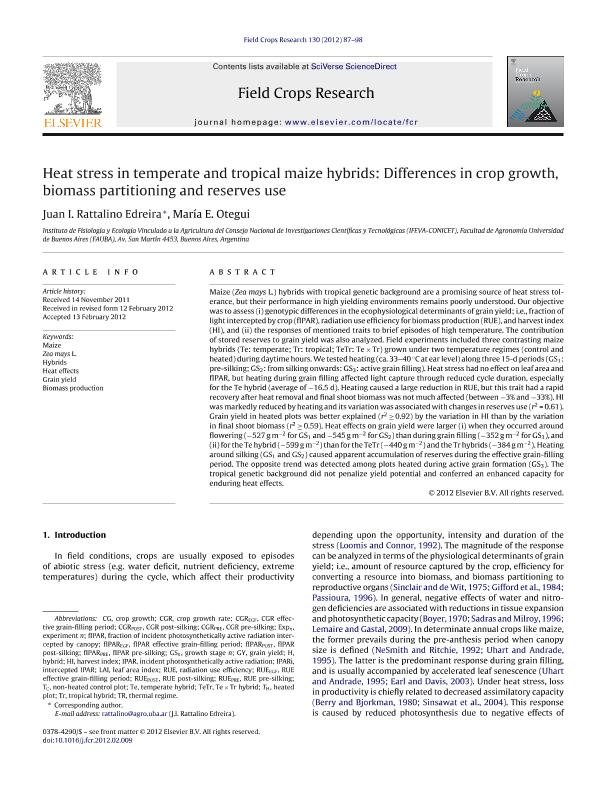Mostrar el registro sencillo del ítem
dc.contributor.author
Rattalino Edreira, Juan Ignacio

dc.contributor.author
Otegui, Maria Elena

dc.date.available
2018-09-24T14:11:58Z
dc.date.issued
2012-03
dc.identifier.citation
Rattalino Edreira, Juan Ignacio; Otegui, Maria Elena; Heat stress in temperate and tropical maize hybrids: Differences in crop growth, biomass partitioning and reserves use; Elsevier Science; Field Crops Research; 130; 3-2012; 87-98
dc.identifier.issn
0378-4290
dc.identifier.uri
http://hdl.handle.net/11336/60713
dc.description.abstract
Maize (Zea mays L.) hybrids with tropical genetic background are a promising source of heat stress tolerance, but their performance in high yielding environments remains poorly understood. Our objective was to assess (i) genotypic differences in the ecophysiological determinants of grain yield; i.e., fraction of light intercepted by crop (fIPAR), radiation use efficiency for biomass production (RUE), and harvest index (HI), and (ii) the responses of mentioned traits to brief episodes of high temperature. The contribution of stored reserves to grain yield was also analyzed. Field experiments included three contrasting maize hybrids (Te: temperate; Tr: tropical; TeTr: Te×Tr) grown under two temperature regimes (control and heated) during daytime hours. We tested heating (ca. 33-40°C at ear level) along three 15-d periods (GS 1: pre-silking; GS 2: from silking onwards: GS 3: active grain filling). Heat stress had no effect on leaf area and fIPAR, but heating during grain filling affected light capture through reduced cycle duration, especially for the Te hybrid (average of -16.5 d). Heating caused a large reduction in RUE, but this trait had a rapid recovery after heat removal and final shoot biomass was not much affected (between -3% and -33%). HI was markedly reduced by heating and its variation was associated with changes in reserves use (r 2=0.61). Grain yield in heated plots was better explained (r 2≥0.92) by the variation in HI than by the variation in final shoot biomass (r 2≥0.59). Heat effects on grain yield were larger (i) when they occurred around flowering (-527gm -2 for GS 1 and -545gm -2 for GS 2) than during grain filling (-352gm -2 for GS 3), and (ii) for the Te hybrid (-599gm -2) than for the TeTr (-440gm -2) and the Tr hybrids (-384gm -2). Heating around silking (GS 1 and GS 2) caused apparent accumulation of reserves during the effective grain-filling period. The opposite trend was detected among plots heated during active grain formation (GS 3). The tropical genetic background did not penalize yield potential and conferred an enhanced capacity for enduring heat effects. © 2012 Elsevier B.V.
dc.format
application/pdf
dc.language.iso
eng
dc.publisher
Elsevier Science

dc.rights
info:eu-repo/semantics/openAccess
dc.rights.uri
https://creativecommons.org/licenses/by-nc-sa/2.5/ar/
dc.subject
Biomass Production
dc.subject
Grain Yield
dc.subject
Heat Effects
dc.subject
Hybrids
dc.subject
Maize
dc.subject
Zea Mays L.
dc.subject.classification
Agricultura

dc.subject.classification
Agricultura, Silvicultura y Pesca

dc.subject.classification
CIENCIAS AGRÍCOLAS

dc.title
Heat stress in temperate and tropical maize hybrids: Differences in crop growth, biomass partitioning and reserves use
dc.type
info:eu-repo/semantics/article
dc.type
info:ar-repo/semantics/artículo
dc.type
info:eu-repo/semantics/publishedVersion
dc.date.updated
2018-09-10T16:30:23Z
dc.journal.volume
130
dc.journal.pagination
87-98
dc.journal.pais
Países Bajos

dc.journal.ciudad
Amsterdam
dc.description.fil
Fil: Rattalino Edreira, Juan Ignacio. Consejo Nacional de Investigaciones Científicas y Técnicas. Oficina de Coordinación Administrativa Parque Centenario. Instituto de Investigaciones Fisiológicas y Ecológicas Vinculadas a la Agricultura. Universidad de Buenos Aires. Facultad de Agronomía; Argentina
dc.description.fil
Fil: Otegui, Maria Elena. Consejo Nacional de Investigaciones Científicas y Técnicas. Oficina de Coordinación Administrativa Parque Centenario. Instituto de Investigaciones Fisiológicas y Ecológicas Vinculadas a la Agricultura. Universidad de Buenos Aires. Facultad de Agronomía; Argentina
dc.journal.title
Field Crops Research

dc.relation.alternativeid
info:eu-repo/semantics/altIdentifier/doi/https://dx.doi.org/10.1016/j.fcr.2012.02.009
dc.relation.alternativeid
info:eu-repo/semantics/altIdentifier/url/https://www.sciencedirect.com/science/article/pii/S0378429012000433
Archivos asociados
